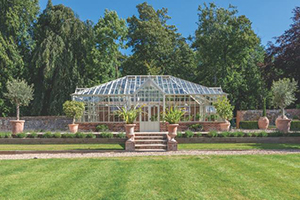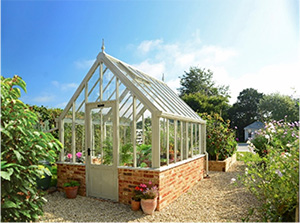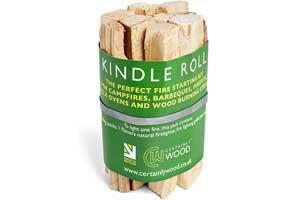Certainly Wood – www.certainlywood.co.uk - has come up with an ingenious little way for campers & holidaymakers to get their fire going without any hassle. The Kindle Roll has an SRP of £1 and is made up from a neat little bundle of 8 poplar kindling sticks together with one of Certainly Wood’s Flamers – a natural firelighter made from wood wool… Read more
Late summer greenhouse growing with Hartley Botanic
Key greenhouse growing jobs and insight for August & September.
The summer is a time when the English garden comes alive, and it is the perfect time to enjoy all your hard work from the vantage point of your beautiful Greenhouse. But for Greenhouse growers, peak to late summer presents its own set of unique challenges and opportunities. Whether that’s managing the heat or propagating for next year. Here, heritage Greenhouse and Glasshouse manufacturer Hartley Botanic provides expert advice on some essential Greenhouse focuses for the late summer season, as well as how to use your Greenhouse as the stepping-off point for a productive winter and growing year.
Insight has been taken from Hartley Botanic’s online magazine, which provides a wealth of knowledge and inspiration. Visit: https://hartley-botanic.co.uk/magazine/

A Hartley Botanic Bespoke Glasshouse, Hampshire, UK
AUGUST – PROPOGATING & STARTING WINTER EDIBLES
Greenhouse propagation
One of the best things about having a Hartley Botanic Greenhouse is being able to propagate plants and mid-summer is the perfect time to start. Semi-ripe cuttings are an easy way to do this with a range of climbers, trees, shrubs, evergreens, herbs and ground cover. The base of the cutting should be hard and ripe, the tip still soft and the material should be healthy. Cuttings should be 10-15cm long and can be ‘heel’ cuttings – pulled way with a sliver of stem or basal cuttings, taken where there is a slight swelling as the side shoot meets the stem. Cut large leaves in half horizontally, dip the base in hormone rooting powder, knock off the excess and put in a 50:50 mix of free draining potting compost and sharp sand or perlite. Put the pots in the Greenhouse and shade from scorching sunshine with netting or newspaper. Greenhouses with roller blind shading provide extra cover. Keep the compost moist until they root and remove any decaying leaves.
Winter edibles
The sound of autumn seed and plant catalogues thudding onto the doormat, is a reminder that it is time to order seeds for autumn and winter vegetables for the Greenhouse. Most gardeners use the Greenhouse to protect tender plants from frost but if you have any spare room, growing late-cropping edibles is a productive option. Just a little protection makes growth more tender and you can continue cropping tasty salads right through winter. Look ahead and order lettuce like ‘Four Seasons’ and ‘Tom Thumb’, any oriental vegetables, including ‘Pak Choi’ and ‘Mizuna’ greens, ‘Lamb’s Lettuce and spinach like ‘Veneto’ and Radicchio are ideal for late summer sowing and will be ready for harvesting from late September onwards.
It’s also time to plant new potatoes for Christmas or earlier. Late season, second crop potatoes, stored in temperature-controlled conditions to maintain dormancy, are sent out from late July to early August. In warmer areas, plant them outdoors immediately, protecting the foliage with horticultural fleece if frosts are forecast; they will be ready to harvest from late October. In cooler parts of the country where frosts are commonplace, grow them in pots. Stand two or three tubers on a 12.5cm layer of multipurpose compost in a flower pot, at least 30cm wide, then cover with a further 5-7.5cm of compost and water well. When the shoots are 15cm high almost cover them with another layer of compost, continuing the same process as the stems grow until the shoots are within 5-7.5cm of the top of the container. Move them into the Greenhouse before the first frosts; it is a good idea to plant several pots, leaving some to be harvested early and others for Christmas dinner. ‘Carlingford’ and ‘Charlotte’ are two reliable performers. They can also be ‘chitted’ (allowed to produce short shoots) and planted outdoors in late August and Early September. Sow fennel, oriental vegetables like mizuna greens and Pak Choi, rocket, coriander dill, spinach, claytonia and land cress, in modules as soon as you can in August. These will germinate quickly and can be planted out by mid-August for cropping in Autumn. Continue sowing ‘cut and come again’ crops like mixed herbs, in pots, Greenhouse borders or growing bags. Mixed salads can be started in shade under Greenhouse benching then moved outdoors. In late August sow spring onions, Japanese onion lettuce and spring cabbage for transplanting outdoors.
AUGUST – COMBATING THE HEAT
Key growing jobs and insight for August & September
When it comes to summer, it is not only lack of water which will cause plants to fail. When it is extremely hot, there is a potent combination of plants not being able to draw up water fast enough (triggering truss-wrecking ‘blossom end’ rot in tomatoes) and the fierce intensity of the sun magnified by glass. It is often too much for plants, and for the gardener themselves! There are a variety of ways to shade your Greenhouse, whether you choose convenient roller blinds or a completely DIY solution.
Shades or roller blinds on the glazing are a good way to help keep your Greenhouse cool. Hartley Botanic offers both options for the interior of its Greenhouses and this is often preferable to exterior ones, which can rip or even blow off in heavier winds. The best location for roller shades is just below the opening vent where they allow good airflow up the glazing and out of the vent.

A Hartley Botanic Victorian Terrace, Hertfordshire
Having plenty of ventilation is critical to keeping a summertime Greenhouse cool. Ideally, there should be vents not only at the roof ridge to let hot air flow out, but also louvre vents near the ground to allow cooler air to enter. Automatic vents can be very helpful in keeping a Greenhouse ventilated. Fans are also a big help to Greenhouse ventilation, especially in smaller Greenhouses which heat up quickly. They should be positioned to blow air over the tops of plants rather than directly on them to avoid desiccating the leaves, which can sometimes kill a plant. Many nursery growers have fans near the Greenhouse roof to circulate the air but avoid drying out plant leaves. If you don’t have a fan, open the ventilation early in the morning before temperatures rise in the Greenhouse.
SEPTEMBER - RIPENING, CUTTING AND DEADHEADING
September is that wonderful time of year when you continue to reap the reward of your labours with tomatoes, aubergines and peppers ripening, ready for cropping. It’s when plants are at their most ornamental. If you haven’t done so already, begin removing individual leaves around aubergines, peppers and cucumbers to expose them to sunlight and continue feeding with high potash fertiliser to encourage ripening.
There is still time to take cuttings of tender plants to overwinter in the Greenhouse. Bay, rosemary, sage, osteospermum and other tender plants, plus fuchsias and shrubs propagate freely from semi ripe and soft tip cuttings. To take soft tip cuttings, remove young healthy shoots from this year’s growth from 5-10cm long, trim them just below a leaf joint with a sharp pair of secateurs or knife. Trim off the leaves towards the base and dip the bottom 2.5cm in hormone rooting liquid or powder, tapping lightly to remove any excess. Fill a 8cm pot with cutting compost, firm it gently then insert the cuttings round the edge, making a hole with a dibber, so the leaves of adjacent cuttings do not touch each other, then gently firm the compost again. For larger leaved cuttings use one pot per cutting. Water thoroughly, allow to drain, then put the pot in a propagator with a bottom heat of 18-24C or put a central cane in the pot and cover with a clear plastic bag and put a rubber band over the end, then put on a bright spot in the Greenhouse but shaded from direct sunshine. Cuttings take up to four weeks to root, keep the compost moist but not waterlogged and ‘air’ the cuttings every day to prevent fungal infections.
Unless you’re growing plants for their ornamental seed heads or intend to save seed for the following year, ‘deadheading’ by removing the fading flower heads, extends the flowering season. Deadheading is all about keeping your summer plants flowering, both bedding plants, roses and herbaceous perennials. To be effective you don’t just remove the petals of the flower, you need to remove the entire flower, including any developing seeds. If you have lots of summer colour, deadheading can be quite time consuming, but it is the perfect opportunity to lose yourself in the garden and practice a little mindfulness while snipping off those spent summer flowers.

A Hartley Botanic Victorian Planthouse, Berkshire
SEPTEMBER - CLEANING AND ORGANISING
Choose a warm sunny day, towards the end of the month, to remove the Glasshouse shading and give it a clean, before the onset of autumn. It is much more difficult, in the cool and damp of October. Put your potted plants outside in a sheltered sunny spot, covering them with fleece if necessary, then thoroughly tidy, clean and disinfect the Glasshouse. Pull out any weeds that have been hiding behind pots, and plant debris that has escaped your attention - they are ideal places for pests to hide over the winter. Leave the interior until you have cleared away the tomatoes and other tender crops then take the opportunity to tidy, clean and disinfect the inside of the Glasshouse, while you can move plants outside and the weather is still warm.
Clean the glass inside and out, and its doors and partitions (if you have them), paying particular attention to the individual frames and surrounds. A Hartley Botanic Greenhouse does not require a specialist cleaning solution. The glass and aluminum can be easily cleaned using hot water and a diluted household detergent, rinsing the glass with clean water to reduce smears and polishing with a glass cleaning cloth. A flexible scraper such as a plastic plant label is handy to remove any dirt build-up around the edge of windows. Check your gutters are clear of leaves and clean down pipes. Scoop leaves out and flush out debris with a hosepipe or watering can. Clean the floor of your Greenhouse and disinfect all benches, shelving, and equipment with environmentally friendly disinfectant – this will help to control pests and diseases. Warm soapy water and a sponge works best when cleaning blinds, but make sure they are in-situ while you clean. Otherwise you may struggle to refit them - they also dry quicker while extended in the Greenhouse.
Just a reminder, please wear rubber gloves, goggles and take care on ladders. Work methodically, carefully and don’t overreach. Wherever possible, to reduce the risk, try and work from the ground.
All Hartley Botanic’s Glasshouses and Greenhouses are handmade, bespoke and made to order. Customers interested in purchasing a Hartley Botanic Greenhouse should visit: http://www.hartley-botanic.co.uk or call 01457 819 155 for more information.
Hartley Botanic was founded in 1938 by brothers Vincent (RHS fellow) and Norman Hartley following their ground-breaking aluminium Greenhouse design, the first time (to our knowledge) aluminium had been used in Greenhouse construction and marking a huge improvement on its wood and wrought iron Victorian forerunners. The English manufacturer is an authority on Greenhouse design and use over the decades, having been making its beautiful and elegant handmade, made-to-order horticultural buildings for over 84 years from its original factory at the base of the dramatic Pennines’ Chew Valley in Greenfield, Lancashire. It has become synonymous for crafting the finest Greenhouses money can buy through the very highest standards of hard-won experience, craftsmanship and service. A hugely respected brand within the horticultural world, it is the manufacturer of choice for leading organisations, institutions and designers with Hartley Botanic structures commissioned by the RHS, the National Trust, Kew Gardens, Glasgow Botanic Gardens, Massachusetts Horticultural Society, Oxford Botanical Gardens, Le Manoir aux Quat'Saisons, Blenheim Palace, The Lingholm Estate and Hampton Court Palace...to name a few. Its entire product range is endorsed by the Royal Horticultural Society. Here’s why…
‘Why Hartley?’
‘Why Hartley?’ – What makes a Hartley Botanic the finest Glasshouse money can buy
Unrivalled. Unparalleled. Unique. There are Glasshouses and there are Hartley Botanic Glasshouses. Combining inspired design with enduring quality, nothing quite enhances your garden and home like a Hartley Botanic; each one beautifully handmade to last a lifetime.
Why Hartley?
At Hartley Botanic we have had a continuous conversation with our customers over many years. We have collected their comments so as to let you know what our customers say about us, and just why they have chosen a Hartley Botanic Glasshouse.
1. Beauty and Elegance
The incomparable range of simply beautiful and elegant structures means Hartley Botanic can create designs that are distinctive and unique. The Victorian, Heritage and Modern Glasshouse ranges, are so comprehensive you don’t have to go anywhere else to find your beautifully crafted, high-quality Glasshouses from the widest of choices.
2. Structurally Superior
Every Hartley Botanic Glasshouse is handmade in the North of England to your exact requirements. It is made of the finest materials with unparalleled durability, safety, and beauty. All of the aluminium sections have a structural purpose. Short cuts, such as ‘sticking’ aluminium to glass for aesthetic reasons, are never taken. Hartley Botanic are so confident of the structural integrity of their Greenhouses; a 30-year Lifetime Guarantee is offered.
3. A reputation Beyond Compare
Hartley Botanic’s brand heritage and reputation have been built on trust for over 80 years. They have earned an unrivalled reputation for crafting the finest Glasshouses and Greenhouses money can buy through the very highest standards of hard-won experience, craftsmanship and service.
4. Unrivalled Knowledge and Expertise
There is a wealth of knowledge and expertise built into every Hartley Botanic Glasshouse. Generations of customers have put their trust in the hands of expert, time served, highly skilled craftsmen. Glasshouses of distinction are created from decades of knowledge and care.
5. Exceptional Delivery of Service
Once your order has been handmade to your personal requirements, and Hartley Botanic’s exacting standards, your delivery and installation will be exceptional. The proud team at Hartley Botanic are there to ensure the process runs smoothly, providing you with the information you need and keeping you up to date throughout.
- Log in to post comments


